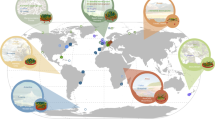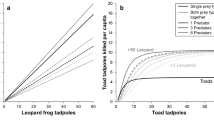Abstract
CENTRAL to our understanding of predator–prey dynamics is the relationship between the death rate imposed on the prey by the predators and the rate of increase, or numerical response, of the predator population. Most of the familiar mathematical models of predator–prey systems involve the assumption that there is a simple linear relationship between the number of prey killed and predator reproduction1–4. Although this assumption is valid for most insect host–parasitoid systems2, the rate of increase of other predatory arthropods is a more complex function of the prey consumed. For successful reproduction, each instar must find and eat several prey to complete development. Thus the predator rate of increase will depend on the duration of, and the survival rate within each instar and the fecundity of the adults. Where models for the predator rate of increase have incorporated more complex nonlinear relationships5,6, these relationships are of too abstract a character to allow simple experimental corroboratiqn or refutation. In this paper we propose models that characterise the effect of prey consumption on the components of the predator rate of increase that are specifically designed to relate our hypotheses to field or laboratory data.
This is a preview of subscription content, access via your institution
Access options
Subscribe to this journal
Receive 51 print issues and online access
$199.00 per year
only $3.90 per issue
Buy this article
- Purchase on Springer Link
- Instant access to full article PDF
Prices may be subject to local taxes which are calculated during checkout
Similar content being viewed by others
References
Lotka, A. J., Elements of physical biology (Williams and Wilkins, Baltimore, 1925).
Hassell, M. P., and May, R. M., J. Anim. Ecol., 42, 693–726 (1973).
Murdoch, W. W., and Oaten, A., Adv. Ecol. Res. (in the press).
Royama, T., Res. Popul. Ecol. Suppl., 1, 1–91 (1971).
Leslie, P. H., Biometrika, 35, 213–45 (1948).
May, R. M., Stability and Complexity in Model Ecosystems (Princeton University Press, Princeton, 1973).
Beddington, J. R., J. Anim. Ecol., 44, 331–340 (1975).
Hassell, M. P., and May, R. M., J. Anim. Ecol., 43, 567–594 (1974).
Holling, C. S., Can. Ent., 91, 385–398 (1959).
Holling, C. S., Mem. Ent. Soc. Can., 48, 1–86 (1966).
Fox, L. R., thesis, Univ. California, Santa Barbara (1973).
Hodek, I., Biology of Coccinellidae (Academia, Prague, 1973).
Turnbull, A. L., Can. Ent., 94, 1233–1249 (1962).
Mukerji, M. K., and LeRoux, E. J., Can. Ent., 101, 387–403 (1969).
Glen, D. M., Ent. exp. appl., 16, 255–267 (1973).
Fransz, H. G., The functional response to prey density in an acarine system (PUDOC, Wageningen, The Netherlands, 1974).
Toth, R. S., and Chew, R. M., Ann. Ent. Soc. Am., 65, 1270–1279 (1972).
Dixon, A. F. G., J. Anim. Ecol., 28, 259–281 (1959).
Dixon, A. F. G., J. Anim. Ecol., 39, 739–751 (1970).
Evans, H. F., thesis, Univ. Oxford (1973).
Pruszynski, S., W.P.R.S. Bulletin, Integrated Control in Glasshouses, 1973–74, 41–46 (1973–74).
Rivard, I., Can. J. Zool., 40, 1233–1236 (1962).
Wratten, S. D., J. Anim. Ecol., 42, 785–802 (1973).
Author information
Authors and Affiliations
Rights and permissions
About this article
Cite this article
LAWTON, J., HASSELL, M. & BEDDINGTON, J. Prey death rates and rate of increase of arthropod predator populations. Nature 255, 60–62 (1975). https://doi.org/10.1038/255060a0
Received:
Accepted:
Issue Date:
DOI: https://doi.org/10.1038/255060a0
This article is cited by
-
10.1007/BF00343380
CrossRef Listing of Deleted DOIs (2011)
-
Predation by Allothrombium pulvinum on the spider mites Tetranychus urticae and Amphitetranychus viennensis: Predation Rate, Prey Preference and Functional Response
Experimental and Applied Acarology (2005)
-
Competition relatedness and efficiency
Nature (1981)
-
Characteristics of successful natural enemies in models of biological control of insect pests
Nature (1978)
Comments
By submitting a comment you agree to abide by our Terms and Community Guidelines. If you find something abusive or that does not comply with our terms or guidelines please flag it as inappropriate.



